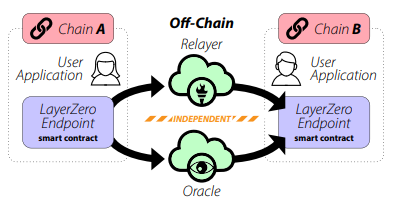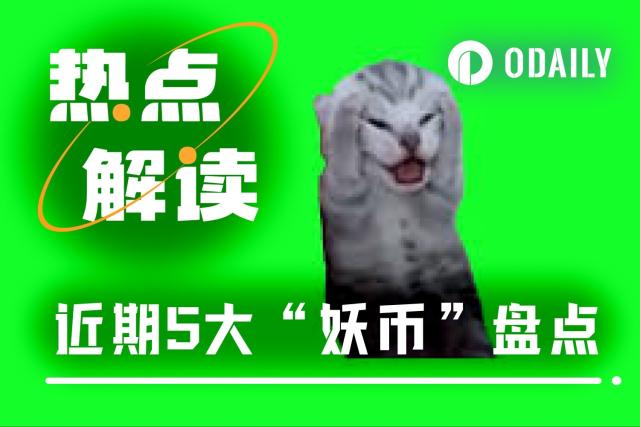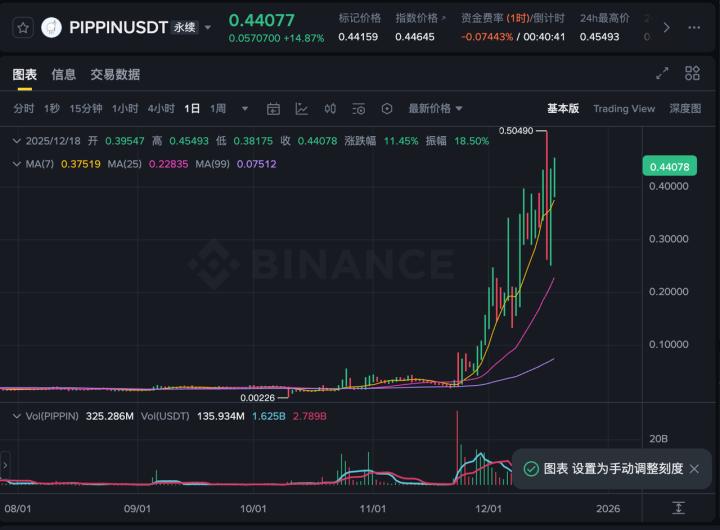(1) Ultra-light nodes
First of all, every node in the blockchain network is actually every computer or server terminal that stores data. Light nodes are just an operation mode of nodes. Unlike full nodes, light nodes only store blockchain data. A small part of , such as block headers and some other information, does not store specific transaction information within the block. Compared with light nodes, ultra-light nodes have the same verification method as light nodes on the chain, but instead of retaining all block headers, they transmit streaming block headers on demand through oracle machines, so as to more efficiently synchronize off-chain entities and reach the desired state.
(2) Core components of LayerZero
According to the LayerZero Whitepaper, there are two core components of LayerZero, namely the oracle (Oracle) and the relay (Relayer).
 The oracle machine is a third-party service that provides a mechanism component independent of other LayerZero, which can read a block header from one chain and send it to another chain, so that the transaction on the source chain can be verified on the target chain. sex. LayerZero uses Chainlink as its oracle.
The oracle machine is a third-party service that provides a mechanism component independent of other LayerZero, which can read a block header from one chain and send it to another chain, so that the transaction on the source chain can be verified on the target chain. sex. LayerZero uses Chainlink as its oracle.
A relayer is an off-chain service that is functionally similar to an oracle, but instead of fetching block headers, it fetches proofs of specified transactions. To ensure efficient delivery, the only requirement is that for any given message sent using the LayerZero protocol, the oracles and relays must be independent of each other. LayerZero can even implement its own relay service. This design allows users to be sure that relayers cannot collude with oracles, and this independence enables LayerZero to achieve trustless verified delivery.
The block header submitted by the oracle machine will be cross-validated with the transaction proof submitted by the relay. The two do not form any consensus and only transmit messages. To put it simply, the oracle acts as a notary in the LayerZero Cross-chain, letting the target chain know the result of the verification, and the repeater is responsible for providing the proof process required to verify the transaction and the specific content of the Cross-chain information.
(3) Operation mode

According to the LayerZero Whitepaper, when a Cross-chain message is to be transmitted (for example, from chain A to chain B), it is first necessary to call the smart contract of LayerZeroEndpoint, and the ultra-light nodes on chain A receive this task and send the message (transaction proof and block header) and the information going to the B-chain to remind the oracle and repeater outside the chain respectively. Here, the oracle and the repeater are independent of each other. The machine obtains the block header information, and the repeater obtains the transaction certificate; when the ultra-light node on the B chain receives the block header message of the oracle machine, the repeater submits the corresponding transaction certificate again, only when the block header message and the proof message match. The real message content will be sent to the B chain to complete the Cross-chain communication.
Both the oracle and repeater can be customized. Users can only use LayerZero's light nodes, and then use different repeaters from LayerZero and different oracles from Chainlink.
2. Advantages
(1) Security
As the underlying protocol, the security of LayerZero is independent of external protocols, thus ensuring the stability of the consensus of the entire protocol. In addition, thanks to the unique design of the oracle and the repeater, the oracle and the repeater are independent of each other, and only when both are considered true will the transaction be completed, ensuring the security of information transmission.
(2) Scalability
LayerZero is a general messaging layer, which means that any contract can be transferred from chain A to chain B to achieve Cross-chain interoperability with L1. Through innovative endpoint design, LayerZero can be easily extended to support any chain, It brings a wider range of application scenarios to the blockchain ecosystem.
(3) High efficiency
First of all, LayerZero's ultra-light node technology can achieve higher transmission efficiency and reduce verification costs while ensuring security; secondly, LayerZero's repeaters or oracles do not form any consensus, only simply transmit messages, all The verification of the transaction is completed on its own target chain, so the speed and throughput limit depends entirely on the properties of the two transaction chains.
4. Development History
2021.05 26 LayerZero Whitepaper released
2022.03 15 Invite former SushiSwap founder 0xmaki to join the team
2022.03.17 LayerZero's Cross-chain protocol Stargate token $STG sale (100 million pieces, accounting for 10% of the total STG issuance, 100 million STG will be locked for 12 months after the auction, and then linearly unlocked in 6 months)
2022.03.18 Stargate mainnet launch
2022.08.11 The decentralized Stablecoin protocol Angle Protocol integrated with LayerZero to realize the Cross-chain transfer of its euro Stablecoin agEUR between Ethereum, Polygon , Optimism and Arbitrum.
2022.09.07 LayerZero launched a full-chain block browser LayerZero Scan
2022.11.20 LayerZero is launched on Metis Goerli testnet
2022.12.01 LayerZero Mainnet integrates Chainlink oracle
2023.02.06 Trade Joe integrated LayerZero, Joe's native token JOE will be transformed into a full-chain token
2023.03.10 LayerZero Labs announced the deployment on the Coinbase Ethereum Layer2 network Base, and the LayerZero endpoint contract has been deployed to the testnet
5. Team background
LayerZero Labs was founded in 2021. According to LinkedIn, there are currently 55 members (including part-time employees). The details of the founding team members are as follows:
Ryan Zarick: Co-founder and CTO of LayerZero Labs, graduated from the University of New Hampshire in the United States with a master's degree in computer science. 22011.11 – 2013.03 as the CTO of BuzzDraft; 2010.09 – 2020.13 as the co-founder of Coder Den; 2018.01 – 2020.03 as the co-founder of 80Trill; 2019.06 – 2021.01 as the co-founder of Minimal AI; Zero and serves as CTO.
Bryan Pellegrino: Co-founder and CEO of LayerZero Labs, graduated from the University of New Hampshire in the United States, majoring in computer science. From 2010.10 to 2013.01, he was the co-founder and COO of Coder Den; from 2011.06 to 2013.01, he was the CEO of BuzzDraft; from 2017.10 to 2019.08, he was the co-founder of OpenToken; from 2016.06 to now, he was the chief engineer of Rho AI; in 2021, he founded LayerZero. Before founding LayerZero, Pellegrino was a professional poker player and co-founded a machine learning company with Ryan Zarick, successfully selling a set of machine learning tools to an MLB team.
Caleb Banister: Founder of LayerZero Labs, graduated from the University of New Hampshire in the United States, majoring in computer science. 2005.06 – 2010.12 as the software developer of UNH Interoperability Lab; 2010.09 – 2021.02 as the co-founder of Coder Den; 2018.03 – 2021.02 as the co-founder of 80Trill; 2019.06 – 2021.02 as the co-founder of Minimal AI; founded in 2021 Layer Zero.
Judging from the resumes of the three co-founders of LayerZeroLabs, the team has excellent machine learning algorithms and innovation capabilities in blockchain development, and has a long-term cooperative relationship with each other, with many years of development experience and successful entrepreneurial experience.
In addition, Sushiswap's Lianchuang 0xmaki also joined the team full-time and served as the chief strategic consultant to help Layerzero's Cross-chain ecological construction.
6. Financing Information
In April 2021, a $2 million seed round of financing was obtained.
In September 2021, LayerZero Labs completed $6.3 million in Series A financing, led by Multicoin and Binance Labs, with participation from Sino Global Capital, Defiance, Delphi Digital, Robot Ventures, Spartan, Hypersphere Ventures, Protocol Ventures, and Gen Block Capital.
In March 2022, LayerZero Labs completed a US$135 million A+ round of financing at a valuation of US$1 billion. a16z, FTX Ventures, and Sequoia Capital jointly led the investment, and Coinbase Ventures, PayPal Ventures, Tiger Global, and Uniswap Labs participated in the investment. (In November 2022, LayerZero issued a document stating that it has repurchased 100% of the equity, currency rights and any other agreements from FTX/FTX Ventures/Alameda Research.)
In April 2023, LayerZero Labs completed a US$120 million Series B round of financing at a valuation of US$3 billion, with participation from a16z Crypto, Christie’s Auction House, Sequoia Capital, Samsung Next, BOND, Circle Ventures, and OpenSea Ventures.
It can be seen that LayerZero has been favored by many large capitals from the very beginning, and has received financing of 263 million US dollars so far. The project has sufficient funds, which can support the advancement of technical products and ensure the long-term development and operation of the project.
7. Development achievements
LayerZero is a full-chain interoperability protocol to achieve Cross-chain state sharing, lending, governance, etc. Currently, LayerZero has supported more than 30 chains including Ethereum, BNB Chain, Avalanche, Aptos, Polygon, Arbitrum, Optimism, and Fantom. The LayerZero ecosystem is expanding rapidly, and has made considerable progress in Defi, NFT, and Cross-chain bridges. details as follows:
 Cross-chain bridge: The previous Cross-chain mode is locking and casting, that is, after the original token is locked by the designated smart contract of the original chain, a new token is minted on the target chain. This Cross-chain bridge method is mainly used for pass-through, but this mode relies on network verification nodes. If nodes do evil or are controlled by hackers, serious losses will be caused, and native assets cannot be sent on different chains. The LayerZero ecological Cross-chain bridge Stargate can seamlessly bridge transactions on the chain. As the first Dapp based on Layerzero, Stargate has broken through the Cross-chain trilemma of instant fund lock, unified Liquidity and native assets. , so as to link the capital Liquidity islands of various public chains and improve capital efficiency.
Cross-chain bridge: The previous Cross-chain mode is locking and casting, that is, after the original token is locked by the designated smart contract of the original chain, a new token is minted on the target chain. This Cross-chain bridge method is mainly used for pass-through, but this mode relies on network verification nodes. If nodes do evil or are controlled by hackers, serious losses will be caused, and native assets cannot be sent on different chains. The LayerZero ecological Cross-chain bridge Stargate can seamlessly bridge transactions on the chain. As the first Dapp based on Layerzero, Stargate has broken through the Cross-chain trilemma of instant fund lock, unified Liquidity and native assets. , so as to link the capital Liquidity islands of various public chains and improve capital efficiency.
DeFi: One of the main problems of DeFi is the lack of Liquidity. LayerZero can achieve interoperability between chains. Developers build Dex or other DeFi applications on specific chains. For users, using LayerZero can stay on the original chain. Any Dex or aggregator conducts Yield Farming from other target chains.
Full-chain NFT: As the first full-chain NFT, Gh0sts has realized Multichain issuance and can realize atomic-level Cross-chain transfer between Multichain . LayerZero realizes that NFT can be moved Cross-chain, and there is no need to split the user group by launching new projects on each chain.
8. Economic Model
LayerZero has not yet issued tokens
9. Risks and opportunities
(1) Risk
The security of LayerZero has not been fully verified, the trust assumption that the oracle and the relayer need to operate independently of each other is still uncertain, and the security risks behind the relay mechanism still need to be vigilant. The important thing is how to realize the relay. decentralized. Moreover, LayerZero outsources the task of verifying information on the chain to third parties such as Chainlink, which will cause uncontrollable security issues to a certain extent, increasing potential risks and uncertainties.
In addition, LayerZero has not yet issued tokens, so it is not sure how the project’s economic model capabilities and token value capture capabilities will be after the project’s token issuance.
(2) Opportunity
With the development of blockchain, the interoperability between chains has become extremely important, and each chain must achieve safe, efficient and seamless interaction. As the underlying protocol, LayerZero is different from the current Cross-chain bridge projects in the market in terms of product design. Using ultra-light node technology, the oracle network is selected to replace the traditional Cross-chain continuous streaming, which makes the protocol more flexible and reduces cost. At present, LayerZero has linked more than 30 chains and is widely used in various ecology. When Multichain coexistence is approaching, LayerZero will have a first-mover advantage and contribute to the development of blockchain ecology.







